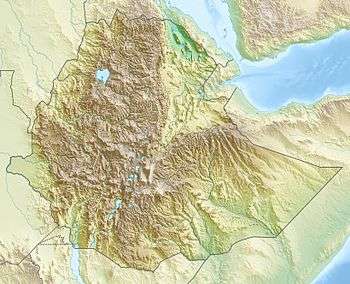Mount Ayalu
| Ayalu | |
|---|---|
 Ayalu Location in Ethiopia | |
| Highest point | |
| Elevation | 2,145 m (7,037 ft) |
| Coordinates | 10°5′N 40°42′E / 10.083°N 40.700°ECoordinates: 10°5′N 40°42′E / 10.083°N 40.700°E |
| Geography | |
| Location | Zone 3, Afar Region, Ethiopia |
Mount Ayalu (also spelled Ayelu) is an isolated, rhyolitic stratovolcano in eastern Ethiopia. Located in Administrative Zone 3 of the Afar Region, near the eastern bank of the Awash River, this mountain has a latitude and longitude of 10°5′N 40°42′E / 10.083°N 40.700°E and an altitude of 2145 meters.
The Argobba have a tradition that after landing in Africa at Zeila, they travelled to this mountain where they settled for a number of years. Here they prospered until their wealth led them to hold weddings and feasts during Ramadan; for this Allah is said to have sent a famine and plagues on them. After this, the people moved to the Ifat Sultanate during its earlier period.[1]

Wilfred Thesiger describes his ascent of Mount Ayalu in 1933. He notes that this mountain was the object of an annual pilgrimage by members of the Afar people, who travelled from as far away as Daoe and Aussa in order to climb to the summit where they would pray for good health and success in war. They would also make a pilgrimage to Ayalu in other times of the year to pray for relief in times of famine and after a defeat in war.[2] When David Buxton visited the site a little more than 10 years later, he was unable to learn if sacrifices were still made there.[3]
The volcano is one of the largest in Ethiopia and is located, along with its close neighbor Adwa (volcano), in a major right step of the linear chain of volcanoes and fissures along the middle of the East African rift. Due to the location of the volcano near the boundary between Afar and Issa tribes, little is known about its past and present behavior. However, an earthquake and InSAR study conducted by Derek Keir and colleagues shows that a magma intrusion around 5 km deep and 8 km long emanated away from the volcano and intruded near the eastern side of neighboring Adwa (volcano) in May 2000.[4]
See also
Notes
- ↑ Aklilu Asfaw, "A short History of the Argobba", Annales d'Éthiopie, 16 (2000), p. 179
- ↑ Wilfred Thesiger, The Danakil Diary: Journeys through Abyssinia, 1930-4 (Hammersmith: Flamingo, 1996), p.
- ↑ David Buxton, Travels in Ethiopia, second edition (London: Benn, 1957), pp. 153ff
- ↑ Keir, D; Pagli, C; Bastow, I; Ayele, A (March 2011). "The magma-assisted removal of Arabia in Afar: Evidence from dike injection in the Ethiopian rift captured using InSAR and seismicity". Tectonics. 30 (2). doi:10.1029/2010TC002785.